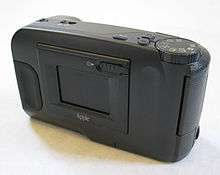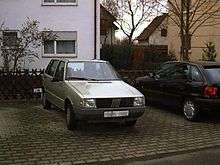Apple QuickTake



The Apple QuickTake (codenamed Venus, Mars, Neptune) is one of the first consumer digital camera lines.[1] It was launched in 1994 by Apple Computer and was marketed for three years before being discontinued in 1997. Three models of the product were built including the 100 and 150, both built by Kodak; and the 200, built by Fujifilm. The QuickTake cameras had a resolution of 640 x 480 pixels maximum (0.3 Mpx). The 200 model is only officially compatible with the Apple Macintosh for direct connections, while the 100 and 150 model are compatible with both the Apple Macintosh and Microsoft Windows.[2] Because the QuickTake 200 is almost identical to the Fuji DS-7 or to Samsung's Kenox SSC-350N, Fuji's software for that camera can be used to gain Windows compatibility for the QuickTake 200. Some other software replacements also exist as well as using an external reader for the removable media of the QuickTake 200.
Time Magazine profiled QuickTake as "the first consumer digital camera" and ranked it among its "100 greatest and most influential gadgets from 1923 to the present" list.[3] While the QuickTake was probably the first digicam to have wide success, technically this is not true as the greyscale Dycam Model 1 (also marketed as the Logitech FotoMan) was the first consumer digital camera to be sold in the US in November 1990. [4][5] At least one other camera, the Fuji DS-X, was sold in Japan even earlier, in late 1989.
History
In 1992, Apple Computer started marketing plans for a digital camera called QuickTake, codenamed Venus. At the time over $12 billion was spent annually in the United States on photography. Apple searched for a company to design and manufacture their QuickTake digital Camera line.
The QuickTake 100 was released in 1994 as an easy-to-use digital camera that connected to any Macintosh computer by way of an Apple serial cable. The camera was capable of storing eight photos at 640×480 resolution, 32 photos at 320×240 resolution, or a mixture of both sizes. All photos were at 24-bit color. The camera had a built-in flash, but no focus or zoom controls. Other than downloading the photos to a computer, there was no way to preview them on the camera, nor was there any way to delete individual photos from the camera (though there was a recessed 'trash' button which would delete the entire contents of the camera). It was one of the first digital cameras released targeted to consumers.
The QuickTake 150 kit included a separate close-up lens that allowed focusing at approximately 30 cm. Apple offered a factory upgrade to the QuickTake 100 changing the name to the QuickTake 100 Plus, which included all the functionality of the QuickTake 150.
Apple released a connection kit for Microsoft Windows with the QuickTake 150 in 1995. The last QuickTake model was the Fujifilm-built QuickTake 200, released in 1996. The 200 added focus and aperture controls, as well as the ability to store images on removable SmartMedia flashRAM cards.
The various QuickTake models did not sell very well, as other companies such as Kodak, Fujifilm, Canon, and Nikon entered the digital market with brands that consumers associated with photography. They were discontinued in 1997 shortly after Steve Jobs came back to Apple. In an attempt to streamline Apple’s operations, Jobs discontinued many non-computer products, including the Newton line of products, the LaserWriter printer line, and the QuickTake cameras. The Apple QuickTake camera has since become a collector's item for Apple enthusiasts.
Specifications
| Model | 100 | 150 | 200 |
|---|---|---|---|
| Image | 24-bit | ||
| Resolution | 640×480 pixels | ||
| Image format | QuickTake, PICT | QuickTake, BMP, JPEG, PCX, TIFF[note 1] | |
| Lens | 8 mm | ||
| 35 mm equivalent | 50 mm | ||
| Memory | 1 MB Flash EPROM | 2 or 4 MB 5 V SmartMedia card | |
| Shutter speed | 1/30 to 1/175 of a second | 1/4 to 1/5000 of a second | |
| Connection | RS-232C | RS-422, RS-232C | RS-232C, NTSC Video I/O |
| Introduced | February 16, 1994 | May 1995 | February 17, 1997 |
| Discontinued | ? | 1997 | |
| Introductory price | 749 USD | 700 USD | 600 USD |
| Aperture | ƒ/2.0 to ƒ/16 | ƒ/2.0 to ƒ/8 (user-selectable) | |
| Battery | 3AA | 4AA | |
- ↑ The QuickTake 150 can only save to the QuickTake file format on the camera. When connected to a computer, however, files from the QuickTake camera can be converted to BMP, JPEG, PCX and TIFF.
Using QuickTake

The QuickTake 200 can be used with card-readers that can read 5V media cards. For users with an Apple Macintosh running System 7 up to Mac OS 9 with a serial port, the QuickTake 200 can be plugged directly into the computer using the Apple QuickTake camera software. The QuickTake 100 and 150 store images internally, not on cards, so they must be used with an Apple serial cable and the QuickTake driver software.
QuickTake cameras cannot be directly connected to Macintoshes running Mac OS X as these machines do not support the old Apple Serial protocol, but image files in the QTK format can still be decoded on modern operating systems using the open source program dcraw or the OS X application GraphicConverter.
See also
References
- ↑ Kaplan, Jeremy (July 26, 2008). "21 Great Technologies that Failed". PC Magazine Online Features. PC Magazine. Retrieved July 27, 2008.
- ↑ http://support.apple.com/kb/TA31906
- ↑ "All-TIME 100 Gadgets". Time Magazine. October 25, 2010. Retrieved January 21, 2012.
- ↑ "Dycam Model 1 / Logitech FotoMan".
- ↑ "Logitech FotoMan digital camera". nationalmediamuseum.org.uk. National Media Museum. Retrieved 2014-06-08.
Creator: Logitech; Dycam Inc. Date: 1990. Description: Logitech FotoMan digital camera, made by Logitech in Switzerland, 1990. The FotoMan was the first digital camera to go on sale.
External links
| Wikimedia Commons has media related to Apple QuickTake. |
- Information about the QuickTake 100 and 360° shot
- QuickTake 200/Fuji DS-7 Users' Page
- Apple Japanese QuickTake 150 Datasheet
- Apple Japanese QuickTake 150 Datasheet(translated)
- WWW Publishing: Graphics - Quicktake 150
- QuickTake camera manuals
- Apple's Forgotten QuickTake Cameras